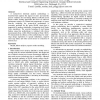Free Online Productivity Tools
i2Speak
i2Symbol
i2OCR
iTex2Img
iWeb2Print
iWeb2Shot
i2Type
iPdf2Split
iPdf2Merge
i2Bopomofo
i2Arabic
i2Style
i2Image
i2PDF
iLatex2Rtf
Sci2ools
ISQED
2009
IEEE
2009
IEEE
Efficient statistical analysis of read timing failures in SRAM circuits
A system-level statistical analysis methodology is described that captures the impact of inter- and intra-die process variations for read timing failures in SRAM circuit blocks. Unlike existing approaches that focus on cell-level performance metrics for isolated sub-components or ignore inter-die variability, the system-level performance is accurately predicted for the entire SRAM circuit that is impractical to analyze statistically via transistor-level Monte Carlo simulations. The accurate bounding of read timing failures using this methodology is validated with silicon measurements from a 64kb SRAM testchip in 90nm CMOS. We demonstrate the efficacy of this methodology for earlystage design exploration to specify redundancy, required sense amp offset, and other circuit choices as a function of memory size. Keywords SRAM, failure analysis, response surface modeling
| Added | 19 May 2010 |
| Updated | 19 May 2010 |
| Type | Conference |
| Year | 2009 |
| Where | ISQED |
| Authors | Soner Yaldiz, Umut Arslan, Xin Li, Larry T. Pileggi |
Comments (0)

